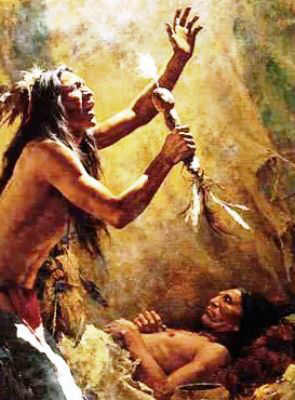Mysterious American Indian Ceremony April 26, 2016
Author: Beach Combing | in : Modern , trackback
This is a curious little snippet of American native religious ritual from the least expected source, a late seventeenth-century book of apparitions. We are introduced first to the protagonist.
A goodly minister, Mr. Farnworth, that came hither from New England (being a Nonconformist and extream poor, dyed as all about him said, of meer Poverty, for want of warm Cloaths, Fire, and Food, when the Act of Uniformity had begger’d many into extream necessity)[.]
So much for ‘Mr. Farnworth’*
he testify’d, that in America, hearing of a Sacrifice to the Devil that the Savages used to keep, by offering a Man to him, he went to see them perform it; and he found a great number about a dry Pit, and they brought an old Man bound, and by many ugly Ceremonies devoted him: And he saw the Man carried up into the Air, and quickly thrown down again dead among them.
Farnworth seems to have doubled then as an amateur anthropologist somewhere in the seventeenth-century colonies. Taken by curiosity (?) he somehow negotiated for himself the possibility of witnessing a human sacrifice: if he just stumbled on it he was likely in danger. Then, an elderly man is tied up. A series of rituals are carried out. The man is then ‘carried into the air’: presumably this was without apparent human intervention because Farnworth believed this to be magical. The elderly man was, then, ‘thrown down’ presumably into the pit?
There are lots of records of human sacrifice among the Indians, but none, which Beach has been capable of tracking down involve being lifted up into the air or hurled down from a height. What kind of ceremony did ‘Mr Farnworth’ actually stumble upon? Can it be paralleled in other historical or anthropological texts: drbeachcombing At yahoo DOt com
Source: Source: Richard Baxter, The Certainty of the World of Spirits (London 1691)
*Attempts to track down Farnworth failed pretty miserably, the surname is, after all, common. In Calamy, The Nonconformist’s Memorial, 2, 637, Baxter’s record is picked up and the author writes ‘Probably this may be the person mentioned at Hockley in Essex’. Peile, Biographical Register of Christ’s College, 1505–1905, 1631, notes that one ‘Mr Farnworth’ substituted John Bolnest but was then ejected in 1662. Farmer in A Genealogical Record of the First Settlers in New England, picks up, instead, on Calamy and notices a seventeenth-century Joseph Farnsworth (note the added ‘s’) in Dorchester, Mass, in 1638. Was Mr Farnworth perhaps Joseph’s son?
Bruce T, 30 April, 2016: He probably witnessed a sacrificial version of a blanket toss. It’s still common among the Inuit and some Algonquin speaking Canadian tribes, but they use it as recreation. I’ve seen footage of Inuit blanket tosses where the person on the blanket will be hurled 10-15 plus feet in the air to be caught by the people holding the blanket. My guess, and it’s only that, is the people the witness encountered let the the old man drop into the pit as the coup de grace of the ceremony.
Ruth B: Okay Beachy, I had to do some checking on this one because it was frankly unfamiliar in what I had learned over the years. As far as I can tell, human sacrifice was probably done on a limited scale. The early Cahokia people are mentioned, who were pre-white colonist tribes in North America. They had ritual funeral sacrificial rites somewhat resembling other cultures. Of the more modern tribes, Plains Indians, Coastal tribes, etc.. there are no mentions of any kind of victim sacrifice, particularly for demonic purposes. There was the torture and killing of enemy warriors, but the killing of women and children were less common as they would become slaves if not killed in the initial attacks. Some of the tribes that went back and forth over the Canadian/American border would at times sacrifice captives or their own members, but again it was more common to keep them as slaves. Yes, there were many pioneers killed when the west was being settled, as well as many innocent Indian villages being wiped out, peaceful or not, during the initial arrival of colonists and in the Indian wars after the Civil War. Some of the Indian tribes felt that if they killed all the trespassers they would stop coming. There are atrocities enough in the records of both sides to keep us all in nightmares for the rest of our lives. But Sacrifices for that kind of purpose were more the lurid imaginations of writers who had no first hand knowledge of life on this continent. I do not include accounts of the Aztec or Maya as it well known they did practice the killing of people for sacrifice to a god or belief system. As an aside, my husband’s family and mine both have Indian ancestors, though more (or less) peacefully married in, but some of his family helped to retrieve a woman who was captured by one of the raiding parties in the 1860’s.


